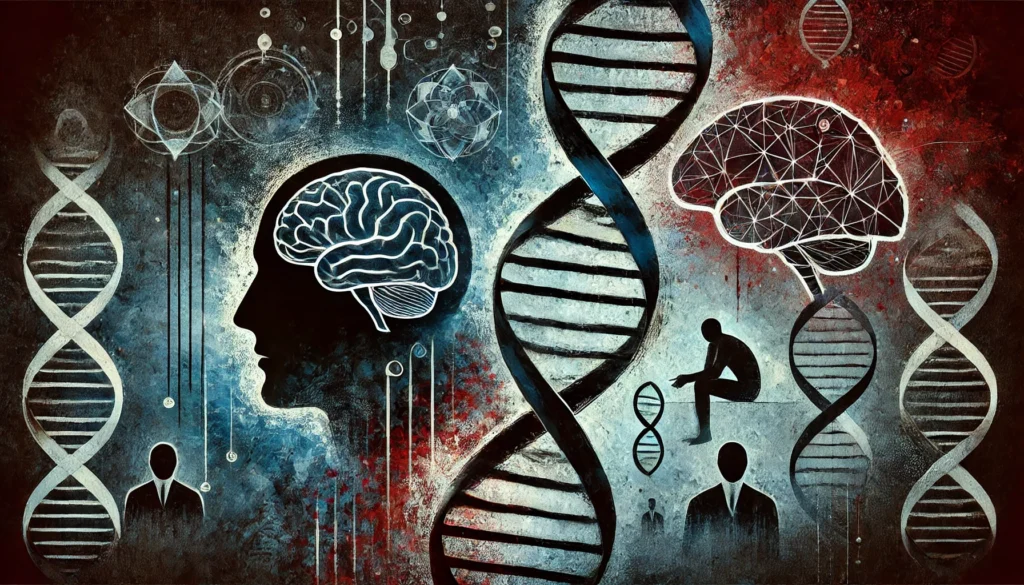Is criminal behavior inherited, or is it shaped solely by environment? This question has intrigued criminologists and geneticists for decades. While environmental factors like upbringing, education, and peer influence undoubtedly play significant roles, there is increasing evidence suggesting that genetics also contribute to criminal tendencies. This article explores the genetic basis of criminal behavior, focusing on three key approaches: family tree studies, twin studies, and the behavioral similarities between parents and children.
1. Family Tree Studies and Crime
The study of family trees provides a fascinating glimpse into how criminal behavior may be inherited across generations. By analyzing families with a high incidence of crime, researchers have aimed to determine whether genetic predispositions play a role in criminal tendencies.
Purpose of Family Tree Analysis
Family tree studies seek to identify hereditary traits that may contribute to behaviors like aggression, impulsivity, and antisocial tendencies. By tracing patterns of criminal activity across generations, researchers aim to separate the influence of genetics from that of shared environmental factors.
Key Findings in Family Tree Studies
One of the most famous examples of such research is the study of the “Jukes family” in the late 19th century. This family, analyzed over several generations, exhibited high rates of crime, poverty, and other social issues. Another notable study examined the “Kallikak family,” highlighting similar patterns of inherited antisocial behavior. These findings fueled early theories that criminal behavior could be passed down genetically.
Limitations of Family Tree Studies
However, family tree studies are not without criticism. It is challenging to separate genetic influences from environmental and cultural factors. For instance, children raised in households with criminal parents may learn and mimic such behaviors rather than inherit them genetically. Furthermore, socioeconomic conditions, such as poverty or lack of access to education, often overlap with family patterns, complicating the analysis.
2. Twin Studies: Nature vs. Nurture in Crime
Twin studies provide a unique approach to understanding the genetic basis of criminal behavior by comparing identical (monozygotic) and fraternal (dizygotic) twins. Identical twins share 100% of their genetic material, while fraternal twins share about 50%. By analyzing differences and similarities in their behavior, researchers can better isolate the impact of genetics versus the environment.
Why Study Twins?
Twin studies are particularly useful in studying criminal behavior because they allow researchers to observe the role of shared genetics in shaping personality traits linked to crime, such as impulsivity and aggression.
Key Findings in Twin Studies
Research has consistently shown higher concordance rates for criminal behavior among identical twins compared to fraternal twins. For example, Karl O. Christiansen’s famous study of twins in Denmark revealed that if one identical twin engaged in criminal behavior, the other was more likely to do so than in fraternal pairs. This suggests a strong genetic component to criminal tendencies.
Environmental Interactions
Despite the compelling evidence, it is essential to consider environmental influences. Even identical twins, who share the same genetic makeup, may behave differently if raised in vastly different environments. Life experiences, peer groups, and socio-economic conditions can shape how genetic predispositions manifest.
Critiques of Twin Studies
Critics of twin studies argue that their small sample sizes and potential biases in recruitment limit the reliability of findings. Moreover, twins often share similar environments, making it difficult to isolate genetics as the sole cause of criminal behavior.

3. Parent-Child Behavioral Similarities in Crime
The behavioral similarities between parents and children offer another critical perspective on the genetic factors influencing criminal tendencies. Studies in this area examine how criminal behavior may be passed from one generation to the next.
Intergenerational Transmission of Crime
Research shows a significant correlation between criminal parents and their children engaging in similar behaviors. This phenomenon is known as intergenerational transmission of crime.
Key Mechanisms
The parent-child connection involves both genetic and environmental influences:
- Genetic Influence: Certain traits like impulsivity, aggression, and a predisposition for risk-taking are often inherited.
- Modeling Behavior: Children are highly influenced by their parents’ actions. If a parent engages in criminal activity, children may view this as acceptable behavior and replicate it in their own lives.
Examples from Research
Studies have highlighted that children of incarcerated parents are more likely to engage in criminal activities themselves. However, these findings suggest a combination of genetic predisposition and environmental factors, such as poor parenting practices or exposure to criminal networks.
Limitations
As with family tree studies, separating the genetic component from environmental influences is challenging. Many children inherit not only their parents’ genes but also their socio-economic disadvantages, which can contribute to criminal behavior.
Conclusion
Genetic factors undoubtedly play a significant role in shaping criminal behavior, as evidenced by family tree studies, twin studies, and intergenerational behavioral analysis. However, genetics do not act in isolation; they interact with environmental and social factors to influence an individual’s actions. Understanding these dynamics is crucial for developing effective crime prevention strategies and fostering a more compassionate approach to rehabilitation.

